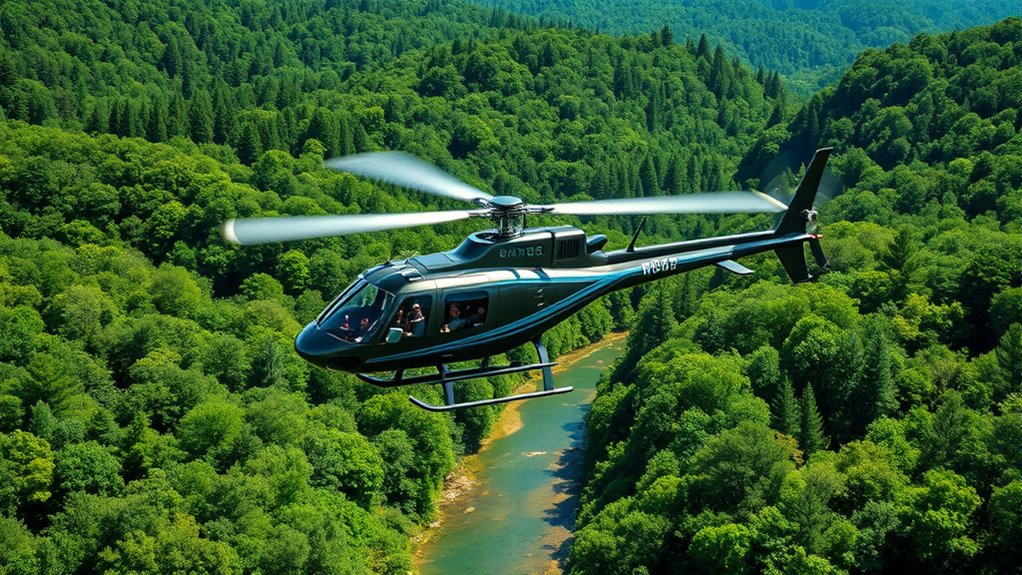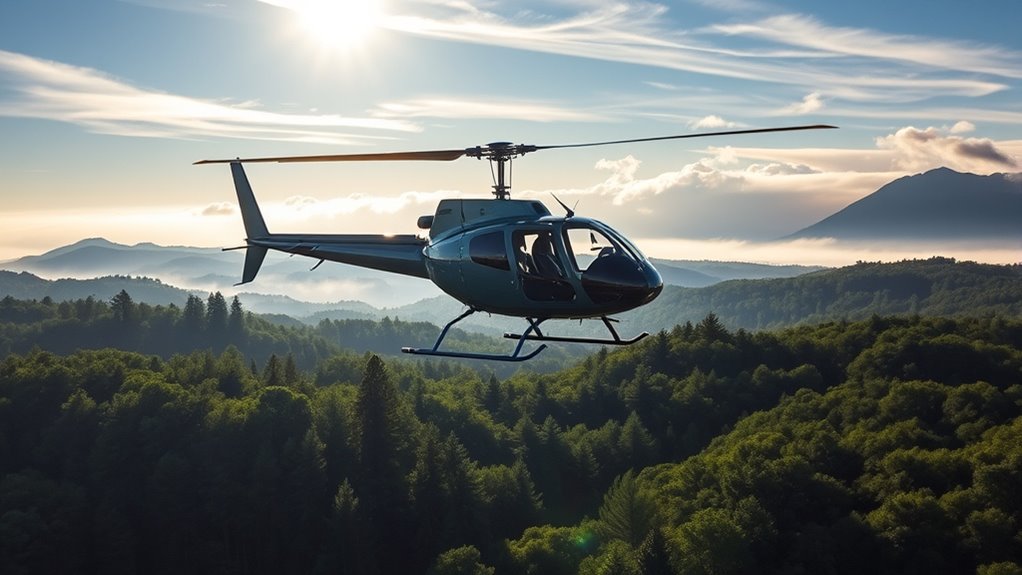Low-impact helicopter tours are increasingly within reach thanks to technological advances like quieter engines, improved rotor designs, and strict regulations to limit noise and habitat disturbance. While they can reduce emissions and wildlife disruption if operated responsibly, the true sustainability depends on adherence to eco-friendly practices and ongoing ecological assessments. If you’re curious about whether these tours are genuinely eco-friendly or just marketing, you’ll find key insights ahead that reveal the real impact.
Key Takeaways
- Innovations like electric propulsion and noise reduction tech have made low-impact helicopter tours increasingly feasible.
- Strict regulations and eco-guidelines help minimize habitat disturbance and ensure sustainable operation.
- Properly operated low-impact tours can significantly reduce noise pollution and wildlife disruption compared to traditional flights.
- Effectiveness depends on flight practices, route choices, and adherence to environmental standards.
- While promising, ongoing reliance on technology and regulation is crucial to ensure low-impact claims are genuine.
The Environmental Impact of Traditional Helicopter Tours

Traditional helicopter tours can substantially harm the environment, primarily through their emissions and noise pollution. The loud engine noise disrupts nearby wildlife, causing stress and altering their natural behaviors. Wildlife disturbance can lead animals to vacate their habitats, affecting feeding, breeding, and migration patterns. The constant drone of helicopters also increases noise pollution, which can extend far beyond the tour routes, impacting ecosystems and local communities. These disturbances can have long-term ecological consequences, especially in sensitive areas like national parks or wildlife reserves. Additionally, wave and wind from helicopter rotors can contribute to shoreline erosion and disturb coastal ecosystems. As a result, traditional helicopter tours often contribute more to environmental degradation than many realize, highlighting the urgent need for more sustainable alternatives that minimize these harmful effects.
Technological Innovations Aiming to Reduce Ecological Footprints

Recent technological innovations are making helicopter tours more environmentally friendly by reducing their ecological footprints. One major advancement is electric propulsion, which cuts emissions and reliance on fossil fuels. Electric engines also deliver smoother operation and lower maintenance costs. Noise reduction technologies are equally important, decreasing the disturbance to wildlife and local communities. To achieve this, manufacturers are implementing quieter rotor designs and sound-dampening materials. Key innovations include:
Electric propulsion and noise reduction tech make helicopter tours greener and quieter.
- Switching to electric propulsion systems for cleaner energy use
- Incorporating advanced noise reduction techniques to minimize sound pollution
- Improving rotor blade design to enhance efficiency and lower environmental impact
- Enhanced materials are being developed to further reduce noise and improve rotor durability
These developments demonstrate that eco-friendly helicopter tours are increasingly feasible, making it easier for you to enjoy scenic experiences responsibly.
Regulatory Measures and Industry Standards

As technological advances make helicopter tours more eco-friendly, industry standards and regulations play a pivotal role in guaranteeing these innovations are effectively implemented and maintained. You must adhere to strict air traffic regulations to minimize environmental impact, such as optimized flight paths and altitude restrictions. Proper pilot training is essential to guarantee pilots operate helicopters efficiently, reducing noise and fuel consumption. Regulatory bodies set guidelines that tour operators follow, promoting sustainable practices. These standards also include maintenance protocols that guarantee helicopters stay eco-friendly over time. By complying with these measures, you help balance tourism with environmental stewardship. Additionally, implementing environmental impact assessments ensures ongoing evaluation of tour operations’ ecological effects.
Comparing Low-Impact Tours to Other Eco-Friendly Travel Options

Low-impact helicopter tours stand out among eco-friendly travel options because they minimize environmental harm through technological innovations and strict regulatory standards. Compared to hiking or biking, helicopter tours can reach remote areas quickly, but they may cause wildlife disturbance and noise pollution. To compare:
Low-impact helicopter tours minimize environmental harm with advanced tech and strict regulations.
- Low-impact helicopter tours reduce noise pollution with quieter engines, lessening wildlife disturbance.
- They often follow strict guidelines to limit flight paths and durations, minimizing habitat disruption.
- Unlike motorized boats or vehicles, helicopters can operate with reduced emissions and impact when properly regulated.
- Additionally, advancements in helicopter technology have contributed to lowering their overall environmental footprint, making them a more sustainable choice in certain contexts.
While other eco-friendly options like eco-lodges or cycling promote sustainability, helicopter tours offer a unique perspective with a smaller footprint—if well-managed. They balance accessibility and environmental responsibility, but must meet high standards to truly be low-impact.
Assessing the True Sustainability of Low-Impact Helicopter Experiences

Evaluating the true sustainability of low-impact helicopter experiences requires examining their operational practices and environmental impacts beyond initial claims. While these tours aim to reduce noise pollution and wildlife disturbance, their effectiveness varies. You should consider how often helicopters fly at low altitudes or in sensitive habitats, as even minimal noise can disturb wildlife and disrupt ecosystems. Additionally, assess the use of modern, quieter helicopter models and eco-friendly fuel options, which can mitigate some environmental effects. It’s essential to look beyond marketing claims and examine real data on noise pollution levels and wildlife responses. Only by scrutinizing these factors can you determine if low-impact helicopter tours genuinely support sustainable tourism or if they merely serve as a marketing tool to mask ongoing environmental concerns. Furthermore, understanding security zone info related to flight paths can help evaluate whether these tours follow environmentally safe routes that minimize disturbance to protected areas.
Frequently Asked Questions
How Do Low-Impact Helicopter Tours Affect Local Wildlife and Ecosystems?
You might wonder how helicopter tours impact wildlife and ecosystems. These tours can cause wildlife disturbance, especially if flights are loud or frequent, disrupting animal behaviors. However, low-impact tours aim to minimize this by reducing noise and flight paths. When done responsibly, they help preserve ecosystem balance, allowing you to enjoy scenic views without markedly harming local wildlife or their habitats. Proper regulations ensure these tours remain sustainable and eco-friendly.
Are There Certifications or Labels Verifying Eco-Friendly Helicopter Tour Operators?
Imagine a lighthouse guiding eco-conscious travelers through the fog—these are eco label certifications. You’ll find some helicopter tour operators proudly displaying these symbols, showing they meet strict sustainability standards. These certifications act as signposts, helping you choose operators committed to reducing environmental impact. While not all operators have them, seeking out these eco labels guarantees you’re supporting tours that prioritize eco-friendly practices and uphold the integrity of sustainable tourism.
What Is the Cost Difference Between Traditional and Low-Impact Helicopter Tours?
You’ll find that low-impact helicopter tours usually cost more than traditional ones, mainly due to their focus on fuel efficiency and reduced emissions. They often use newer technology and more sustainable practices, which can increase maintenance costs. While the price difference varies, you might pay a bit extra for these eco-friendly options, but you’re also supporting more sustainable tourism and reducing environmental impact.
How Do Customer Experiences Compare Between Eco-Focused and Conventional Helicopter Tours?
Ever wondered how eco-focused helicopter tours stack up against traditional ones? You’ll find passenger comfort remains high, with quieter flights and smoother rides, making your experience more enjoyable. Visual engagement is also enhanced, as these tours often emphasize scenic routes and environmental awareness. Don’t you want to feel good about your adventure while still enjoying breathtaking views? Ultimately, eco-focused tours often leave travelers more satisfied and connected to nature.
Can Low-Impact Helicopter Tours Operate in Remote or Protected Natural Areas?
You wonder if low-impact helicopter tours can operate in remote or protected natural areas. Yes, they can, because they’re designed to reduce noise pollution and visual disturbance, minimizing the impact on sensitive ecosystems. These tours often use quieter, more efficient technology, allowing you to experience pristine environments without causing significant disruption. So, with proper planning and regulation, low-impact tours can access remote areas while safeguarding their natural beauty.
Conclusion
While low-impact helicopter tours aim to minimize environmental harm, don’t assume they’re entirely eco-friendly. Technological advances and regulations help, but the core footprint remains. If you seek truly sustainable travel, consider alternatives like eco-friendly cruises or train journeys. Ultimately, understanding that even “low-impact” options aren’t perfect encourages more mindful choices. Balancing adventure with responsibility means recognizing the limitations of current innovations while supporting ongoing efforts to reduce ecological footprints.










